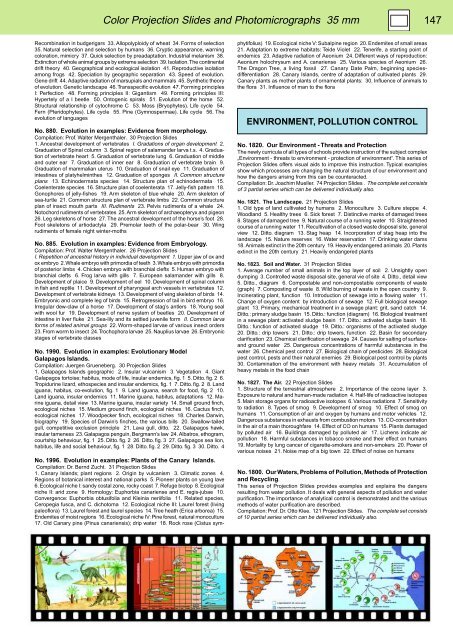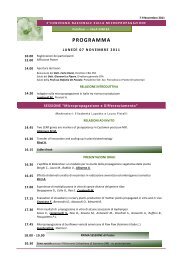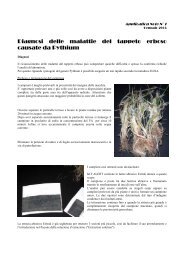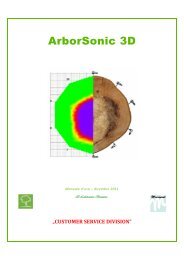BIOLOGY - microscopia.info
BIOLOGY - microscopia.info
BIOLOGY - microscopia.info
Create successful ePaper yourself
Turn your PDF publications into a flip-book with our unique Google optimized e-Paper software.
Color Projection Slides and Photomicrographs 35 mm 147<br />
Recombination in budgerigars 33. Allopolyploidy of wheat 34. Forms of selection<br />
35. Natural selection and selection by humans 36. Cryptic appearance, warning<br />
coloration, mimicry 37. Quick selection by preadaptation. Industrial melanism 38.<br />
Extinction of whole animal groups by extreme selection 39. Isolation. The continental<br />
drift theory 40. Geographical and ecological isolation 41. Reproductive isolation<br />
among frogs 42. Speciation by geographic separation 43. Speed of evolution.<br />
Gene drift 44. Adaptive radiation of marsupials and mammals 45. Synthetic theory<br />
of evolution. Genetic landscape 46. Transspecific evolution 47. Forming principles<br />
I: Perfection 48. Forming principles II: Gigantism 49. Forming principles III:<br />
Hypertely of a l beetle 50. Ontogenic spirals 51. Evolution of the horse 52.<br />
Structural relationship of cytochrome C 53. Moss (Bryophytes). Life cycle 54.<br />
Fern (Pteridophytes). Life cycle 55. Pine (Gymnospermae). Life cycle 56. The<br />
evolution of languages<br />
No. 880. Evolution in examples: Evidence from morphology.<br />
Compilation: Prof. Walter Mergenthaler. 30 Projection Slides<br />
1. Ancestral development of vertebrates I. Gradations of organ development 2.<br />
Graduation of Spinal column 3. Spinal region of salamander larva t.s. 4. Graduation<br />
of vertebrate heart 5. Graduation of vertebrate lung 6. Graduation of middle<br />
and outer ear 7. Graduation of inner ear 8. Graduation of vertebrate brain 9.<br />
Graduation of mammalian uterus 10. Graduation of snail eye 11. Graduation of<br />
intestines of platyhelminthes 12. Graduation of sponges II. Common structure<br />
plans 13. Echinodermata species 14. Structure plan of echinodermata 15.<br />
Coelenterate species 16. Structure plan of coelenterata 17. Jelly-fish pattern 18.<br />
Gonophores of jelly-fishes 19. Arm skeleton of blue whale 20. Arm skeleton of<br />
sea-turtle 21. Common structure plan of vertebrate limbs 22. Common structure<br />
plan of insect mouth parts III. Rudiments 23. Pelvis rudiments of a whale 24.<br />
Notochord rudiments of vertebrates 25. Arm skeleton of archaeopteryx and pigeon<br />
26. Leg skeletons of horse 27. The ancestral development of the horse’s foot 28.<br />
Foot skeletons of artiodactyla 29. Premolar teeth of the polar-bear 30. Wing<br />
rudiments of female night winter-moths<br />
No. 885. Evolution in examples: Evidence from Embryology.<br />
Compilation: Prof. Walter Mergenthaler. 26 Projection Slides<br />
I. Repetition of ancestral history in individual development 1. Upper jaw of ox and<br />
ox embryo 2. Whale embryo with primordia of teeth 3. Whale embryo with primordia<br />
of posterior limbs 4. Chicken embryo with branchial clefts 5. Human embryo with<br />
branchial clefts 6. Frog larva with gills 7. European salamander with gills 8.<br />
Development of plaice 9. Development of eel 10. Development of spinal column<br />
in fish and reptile 11. Development of pharyngeal arch vessels in vertebrates 12.<br />
Development of vertebrate kidneys 13. Development of wing skeleton of birds 14.<br />
Embryonic and complete leg of birds 15. Retrogression of tail in bird embryo 16.<br />
Irregular dew-claw of a horse 17. Development of stag’s antlers 18. Young seal<br />
with wool fur 19. Development of nerve system of beetles 20. Development of<br />
intestine in liver fluke 21. Sea-lily and its settled juvenile form II. Common larva<br />
forms of related animal groups 22. Worm-shaped larvae of various insect orders<br />
23. From worm to insect 24. Trochophora larvae 25. Nauplius larvae 26. Embryonic<br />
stages of vertebrate classes<br />
No. 1990. Evolution in examples: Evolutionary Model<br />
Galapagos Islands.<br />
Compilation: Juergen Grueneberg. 30 Projection Slides<br />
1. Galapagos Islands geographic 2. Insular vulcanism 3. Vegetation 4. Giant<br />
Galapagos tortoise; habitus, mode of life, insular endemics, fig. 1 5. Ditto. fig. 2 6.<br />
Tropidurine lizard, ethospecies and insular endemics, fig. 1 7. Ditto. fig. 2 8. Land<br />
iguana, habitus, co-evolution, fig. 1 9. Land iguana, search for food, fig. 2 10.<br />
Land iguana, insular endemics 11. Marine iguana, habitus, adaptations 12. Marine<br />
iguana, detail view 13. Marine iguana, insular variety 14. Small ground finch,<br />
ecological niches 15. Medium ground finch, ecological niches 16. Cactus finch,<br />
ecological niches 17. Woodpecker finch, ecological niches 18. Charles Darwin,<br />
biography 19. Species of Darwin’s finches, the various bills 20. Swallow-tailed<br />
gull, competitive exclusion principle 21. Lava gull, ditto. 22. Galapagos hawk,<br />
insular tameness 23. Galapagos penguin, Bergmann’s law 24. Albatros, ethogram,<br />
courtship behaviour, fig. 1 25. Ditto. fig. 2 26. Ditto. fig. 3 27. Galapagos sea lion,<br />
habitus, life and social behaviour, fig. 1 28. Ditto. fig. 2 29. Ditto. fig. 3 30. Ditto. 4<br />
No. 1996. Evolution in examples: Plants of the Canary Islands.<br />
Compilation: Dr. Bernd Zucht. 31 Projection Slides<br />
1. Canary Islands; plant regions 2. Origin by vulcanism 3. Climatic zones 4.<br />
Regions of botanical interest and national parks 5. Pioneer plants on young lave<br />
6. Ecological niche I: sandy costal zone, rocky coast 7. Refuge biotop 8. Ecological<br />
niche II: arid zone 9. Homology: Euphorbia canariense and E. regis-jubae 10.<br />
Convergence: Euphorbia obtusifolia and Kleinia neriifolia 11. Related species,<br />
Ceropegia fusca, and C. dichotoma 12. Ecological niche III: Laurel forest (living<br />
paleoflora) 13. Laurel forest and laurel species 14. Tree heath (Erica arborea) 15.<br />
Endemites of moist regions 16. Ecological niche IV: Pine forest, natural monoculture<br />
17. Old Canary pine (Pinus canariensis); drip water 18. Rock rose (Cistus sym-<br />
phytifolius) 19. Ecological niche V: Subalpine region 20. Endemites of small areas<br />
21. Adaptation to extreme habitats: Teide Violet 22. Tenerife, a starting point of<br />
endemics 23. Adaptive radiation of Aeonium 24. Different ways of reproduction:<br />
Aeonium holochrysum and A. canariense 25. Various species of Aeonium 26.<br />
The Dragon Tree, a living fossil 27. Canary Date Palm, beginning speciesdifferentiation<br />
28. Canary Islands, centre of adaptation of cultivated plants 29.<br />
Canary plants as mother plants of ornamental plants: 30. Influence of animals to<br />
the flora 31. Influence of man to the flora<br />
ENVIRONMENT, POLLUTION CONTROL<br />
No. 1820. Our Environment - Threats and Protection<br />
The newly curricula of all types of schools provide instruction of the subject complex<br />
„Environment - threats to environment - protection of environment“. This series of<br />
Projection Slides offers visual aids to improve this instruction. Typical examples<br />
show which processes are changing the natural structure of our environment and<br />
how the dangers arising from this can be counteracted.<br />
Compilation: Dr. Joachim Mueller. 74 Projection Slides . The complete set consists<br />
of 3 partial series which can be delivered individually also.<br />
No. 1821. The Landscape. 21 Projection Slides<br />
1. Old type of land cultivated by humans 2. Monoculture 3. Culture steppe 4.<br />
Woodland 5. Healthy trees 6. Sick forest 7. Distinctive marks of damaged trees<br />
8. Stages of damaged tree 9. Natural course of a running water 10. Straightened<br />
course of a running water 11. Recultivation of a closed waste disposal site, general<br />
view 12. Ditto. diagram 13. Stag heap 14. Incorporation of stag heap into the<br />
landscape 15. Nature reserves 16. Water reservation 17. Drinking water dams<br />
18. Animals extinct in the 20th century 19. Heavily endangered animals 20. Plants<br />
extinct in the 20th century 21. Heavily endangered plants<br />
No. 1823. Soil and Water. 31 Projection Slides<br />
1. Average number of small animals in the top layer of soil 2. Unsightly open<br />
dumping 3. Controlled waste disposal site, general vie of site 4. Ditto., detail view<br />
5. Ditto., diagram 6. Compostable and non-compostable components of waste<br />
(graph) 7. Composting of waste 8. Wild burning of waste in the open country 9.<br />
Incinerating plant, function 10. Introduction of sewage into a flowing water 11.<br />
Change of oxygen content by introduction of sewage 12. Full biological sewage<br />
plant 13. Primary, mechanical treatment in a sewage plant: grit, sand catch 14.<br />
Ditto.: primary sludge basin 15. Ditto.: function (diagram) 16. Biological treatment<br />
in a sewage plant: activated sludge basin 17. Ditto.: activated sludge basin 18.<br />
Ditto.: function of activated sludge 19. Ditto.: organisms of the activated sludge<br />
20. Ditto.: drip towers 21. Ditto.: drip towers, function 22. Basin for secondary<br />
clarification 23. Chemical clarification of sewage 24. Causes for salting of surfaceand<br />
ground water 25. Dangerous concentrations of harmful substances in the<br />
water 26. Chemical pest control 27. Biological chain of pesticides 28. Biological<br />
pest control, pests and their natural enemies 29. Biological pest control by plants<br />
30. Contamination of the environment with heavy metals 31. Accumulation of<br />
heavy metals in the food chain<br />
No. 1827. The Air. 22 Projection Slides<br />
1. Structure of the terrestrial atmosphere 2. Importance of the ozone layer 3.<br />
Exposure to natural and human-made radiation 4. Half-life of radioactive isotopes<br />
5. Main storage organs for radioactive isotopes 6. Various radiations 7. Sensitivity<br />
to radiation 8. Types of smog 9. Development of smog 10. Effect of smog on<br />
humans 11. Consumption of air and oxygen by humans and motor vehicles 12.<br />
Dangerous substances in exhausts from combustion motors 13. CO-concentration<br />
in the air of a main thoroughfare 14. Effect of CO on humans 15. Plants damaged<br />
by polluted air 16. Buildings damaged by polluted air 17. Lichens indicate air<br />
pollution 18. Harmful substances in tobacco smoke and their effect on humans<br />
19. Mortality by lung cancer of cigarette-smokers and non-smokers 20. Power of<br />
various noises 21. Noise map of a big town 22. Effect of noise on humans<br />
No. 1800. Our Waters, Problems of Pollution, Methods of Protection<br />
and Recycling.<br />
This series of Projection Slides provides examples and explains the dangers<br />
resulting from water pollution. It deals with general aspects of pollution and water<br />
purification. The importance of analytical control is demonstrated and the various<br />
methods of water purification are described.<br />
Compilation: Prof. Dr. Otto Klee. 121 Projection Slides. The complete set consists<br />
of 10 partial series which can be delivered individually also.







